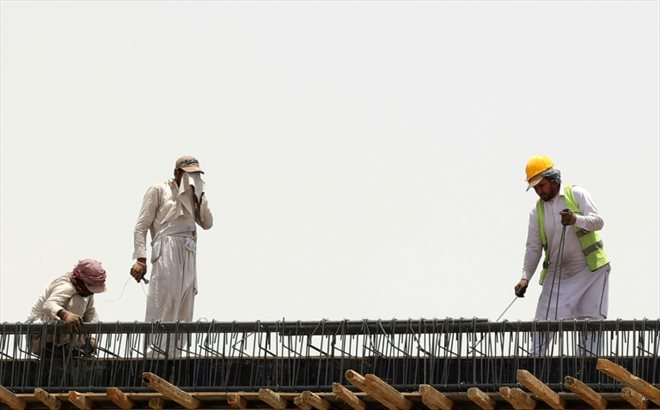A worker pours water on his head to cool off in the city of Sharjah, United Arab Emirates, on June 20, 2022 (AFP/Karim SAHIB)
Summer has barely begun and temperatures are already above 50 degrees Celsius in some Gulf Arab countries, which are at risk of becoming unlivable due to global warming, experts say.
For the millions of migrants who work on construction sites in this desert region but rich in hydrocarbons, the summer season is synonymous with ordeal.
“We work in very high temperatures. We suffer from the heat,” B. Sajay, an Indian worker who has been employed for six years in Muscat, the capital of Oman, one of the six countries of the Council, told AFP. Gulf cooperation.
“The only thing that relieves us is the rest period (…) in the middle of the day,” he adds.
The sultanate, like the other Gulf countries – the United Arab Emirates, Qatar, Saudi Arabia, Bahrain and Kuwait – depends heavily on cheap foreign labor, mainly from Asia.
Thousands of young workers arrive in the region each year to perform jobs that the citizens of the host countries refuse to perform, in the oil industry, construction, cleaning or garbage collection.
– Hottest decade –
There are no reliable data on the number of migrant workers who have died in the Gulf countries, which do not publish figures and regularly dispute the estimates of NGOs and the media.

Workers working on a construction site in the Omani capital, Muscat, on June 21, 2022 (AFP/MOHAMMED MAHJOUB)
A survey conducted by the Viral Sign Partnership, which brings together several NGOs mainly based in Asian countries, indicates that some 10,000 migrant workers from South and Southeast Asia die in the Gulf each year. According to this report published in March 2022, more than half of deaths are classified as “cardiac arrest” or “natural death”.
During the period of strong heat, between June and August, outdoor work is legally prohibited between noon and approximately 4 p.m.
The workers then huddle in the rare areas sheltered from the sun, while waiting for the resumption of work, the temperatures regularly exceeding 45 degrees.
Already in May, the mercury hit 53.2 degrees in Kuwait, the hottest place on earth that day.
“The last ten years have been the hottest” in the country, says Kuwaiti meteorologist Issa Ramadan, pointing out that “summer now extends until September and sometimes until part of the month of ‘october”.

A foreign worker rides a bicycle in scorching heat in Sharjah, United Arab Emirates, on June 20, 2022 (AFP/Karim SAHIB)
Under the scorching sun of Muscat, Oman, workers paving the road cover their heads in colorful scarves and hats, while others take shelter under date palms.
“To finish the eight hours of work as soon as possible, I sometimes start as early as six in the morning. I stop during the rest period, then I do two more hours,” said Muhammad Mukarram, a Bangladeshi construction worker.
In Qatar, human rights organizations have called on the host country of the 2022 World Cup to protect the hundreds of thousands of migrants working on the construction sites of the world, and to investigate the cases of death linked to “thermal distress”. “.
– Deadly heat –
The Gulf region has the hottest and wettest climate on the planet, according to a 2020 study published in the journal Science Advances.
In this study, scientists calculated the wet-bulb globe temperature index (WBGT in English, different from degrees Celsius), which measures the effect of heat, humidity and solar radiation on the ‘man.

Workers at a construction site in Riyadh, the capital of Saudi Arabia, on June 16, 2022 (AFP/Fayez Nureldine)
They concluded that a healthy adult could not survive a temperature of 35 degrees WBGT for more than six hours, even in shade and with plenty of water.
However, this temperature has been reached 14 times in the world over the past twenty years, including eight in the Gulf.
Another study, published in the journal Nature Climate Change, also raised the risk that the region will be hit by “unprecedented episodes of deadly heat due to climate change”, and that large cities will become uninhabitable, even in areas shaded and well ventilated.
“If we don’t change course, temperatures will continue to rise to the point where outdoor activities in the Gulf, such as the Hajj pilgrimage, would be almost impossible in the summer,” warns Julien Jreissati, regional program director at Greenpeace.
Saudi Arabia is set to welcome one million Muslim pilgrims next month after two years of pandemic restrictions.
“The only solution is to reduce our reliance on fossil fuels, which are the main driver of climate change, and make a gradual but rapid transition to renewable energy,” he adds.
© 2022 AFP
Did you like this article ? Share it with your friends with the buttons below.




